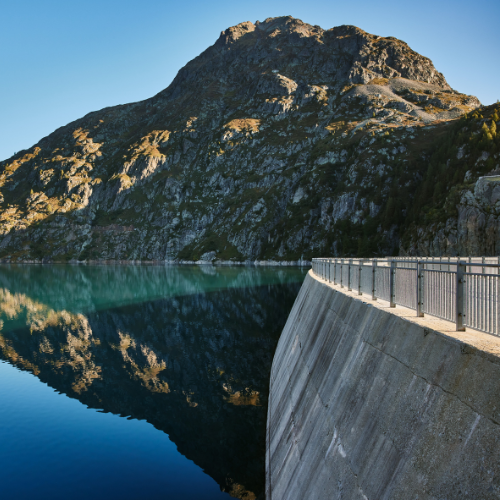Nurturing life on land and in water
(GRI 3-3)

Alpiq builds, owns and operates production facilities whose location is strongly influenced by the natural resource used. The location of these facilities, particularly those using renewable energy, leads to construction in areas occupied by natural environments worthy of protection.
We manage the construction and operation of our production sites proactively to minimise their impact and to promote the existing biodiversity. We collaborate with different interest groups and implement remediation, renaturation and compensation measures for our development projects and for the watercourses on which we operate at the earliest stages.
We commit to having a long-term net positive impact on nature and we go beyond the mandatory environmental regulations whenever possible. We also develop environmental expertise internally to improve the overall environmental quality of our projects. Environmental assessment, including nature and biodiversity, is a key part of all our projects and plays an important role in driving our strategic choices, even at an early stage. Alpiq is currently planning to develop an environmental policy to harmonise the principles and objectives within the Group.
As part of the quality management applied to environmental issues, monitoring of environmental incidents (without consequences on environment) and accidents (with impact on environment) are being introduced in 2023 at the Business Unit Hydro Generation Switzerland. Environmental incidents and accidents are identified, consolidated, and analysed with the dual aim of ensuring that the appropriate measures have been taken and that any feedback can then be used effectively. In 2023, three minor accidents were identified. In all three cases, appropriate measures were taken on site to ensure that no pollution remained. In addition, operational procedures have been adapted for future operations.
Our hydropower plants capture water from rivers to convert it into energy. The water is extracted upstream of the facility, turbined and then returned downstream. From an environmental point of view, the consequences for the phase between extraction and release vary from case to case. The impact of these withdrawals on the ecology of Switzerlandʼs watercourses has been assessed in accordance with the Federal Water Protection Act. For all the facilities managed by Alpiq, 37 remediation measures have been identified, studied and, for the most part, implemented.

Existing power plants and their impact on life on land and in water are continuously reviewed. In the reporting year, an annual programme was carried out for example to monitor and control the cooling water discharges from the Plana del Vent CCGT in Spain. In this power plant, the cooling water is taken from the sea. Continuous profile measurements of temperature, salinity, turbidity, dissolved oxygen, and density were carried out at several points in the sea in order to physically characterise the water column and the impact of the cooling water discharges. The results of the analyses of the samples show that no signs of disturbance to the marine environment were detected that could be attributed to the operation of the CCGT. In Italy, annual monitoring of all bird species (avifauna) and bat fauna (chiropterofauna) occurring in the region at the wind installations in Sicily was conducted as well.
Milestones
- Environmental studies ongoing for our hydro extension projects for Grande Dixence, Emosson and Moiry heightening, for our new “Gornerli” construction and for three of our Swiss alpine photovoltaic projects (Gondosolar, Prafleuri, Grimentz).
- Completed the environmental studies needed to obtain permits for the San Severo power plant upgrade project to improve efficiency and enable H2 blending
- Monitoring system for environmental incidents and accidents implemented in the Business Unit Hydro Generation Switzerland
Numbers
- 80,000 – investment per year (in EUR) for 4 environmental air quality measurement cabins around Plana del Vent
- 15,700 – investment per year (in EUR) to monitor the quality of the receiving marine environment in the discharge area around Plana del Vent
- 6 – piezometers installed at the Novara and Vercelli power plants to monitor groundwater and soil quality
- 887 – total planned capacity (GWh) of Alpiqʼs four main hydropower winter storage projects
Statement
“At Alpiq, we contribute to a better climate and an improved security of supply in our project pipeline. Rather than chasing returns, we focus on development opportunities to support the European energy transition, taking into account the needs of the environment.”
Ádám Ginter
Manager Strategic Initiatives
Frameworks/Standards
Global Reporting Initiative standards, ISO14001, Environmental Management System (EMAS)
Success stories
New fish pass at the Flumenthal hydropower plant
In 2023, Alpiq built a completely new fish pass at the Flumenthal hydropower plant. From 2024 onwards, the pass will fulfil the current standards for fish migration in the River Aare. Alpiq Hydro Aare AG has invested CHF 10.5 million in the 480-metre bypass watercourse.
More information

Gravel boosts ecosystem in the River Aare
In October, Alpiq poured a total of 5,000 m3 of gravel into the River Aare below the Flumenthal hydropower plant, over around eight days. The aim is to maintain the Aareʼs ecosystem with diverse habitats for animals and plants. Additional pours will follow in the next few years.
More information

#prixalpiq 2023 – from resource management to water consumption
The “Sources and climate change” project run by the Municipality of Martigny and the Centre de Recherche sur lʼEnvironnement Alpin (CREALP) won the #prixalpiq 2023, while the “Winner of Hearts” prize went to “Save water, itʼs easy!”, a joint initiative between the municipalities of Finhaut and Trient.
More information

Nant de Drance: Environmental measures bear fruit
The realisation of the Nant de Drance pumped storage power station in the Valais has an impact on nature. Alpiq is working closely with nature conservation organisations (WWF and Pro Natura) and the authorities to offset this impact and enhance local biodiversity and has invested a total of CHF 22 million in 15 environmental measures.
More information
